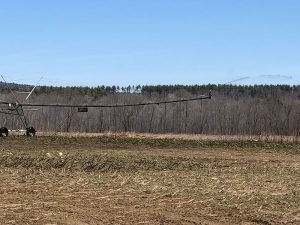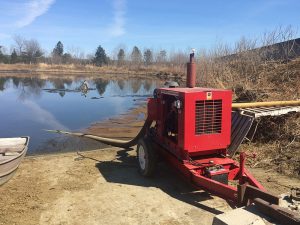Piper Farms Saves Big with a Center Pivot
Piper Farms is a dairy operation located alongside the Kennebec River in Embden, Maine. The farm is operated as a partnership created by Matt and Marsha Hamilton with Lowell and Karen Piper.

Putting a waste product to use
The farm milks 525 cows three times daily, with about 4,000 gallons of water used per day to flush the milk room. Unlike other farms which might combine manure solids with the milk room wastewater or gray water, Piper Farm diverts the wastewater to its own holding pool below the milk room. Beyond the pool expands 60 acres of flat, sandy cropland adjacent to the river. Matt recalled a time about five years ago when the fields were dry and the farmers were pumping irrigation water from the river to feed into their center pivot irrigation system. “Why can’t we do gray water instead?” Matt asked. Since then, the farm has been running gray water through their center pivot to irrigate the 60-acre parcel that is in no-till corn.

Running gray water through the center pivot
The gray water is filtered through a screened suction line that floats in the center of the 8-foot-deep holding pool. A generator pumps the gray water into a pipe feeding into the center pivot. The computer-programmed center pivot sprays 350 gallons per minute and spreads 0.3 inches of water per acre. It takes approximately 7-10 days to empty the holding pool down to a layer of solids. In terms of challenges, Matt said the screens on the suction line can clog with manure and sand and lose suction. However, Matt recognizes that the benefits of using the center pivot outweigh the cons in terms of soil heath benefits and costs.
Soil health side effects
The alternative to the center pivot is to truck and spread the gray water directly on the fields or to another storage pond. Matt estimates this would take a month of hauling or about 400 trips over the fields. While the center pivot saves on trucking fuel and labor it also reduces the threat of soil compaction. Soil compaction causes a general deterioration of the soil structure. Compaction decreases porosity which reduces water infiltration, air and gas exchangeability, and root penetration. Matt hasn’t measured soil compaction directly but has anecdotally noted the soil feels more “cushiony” underfoot since starting. Down the road, Piper Farms looks forward to monitoring how this practice in combination with cover cropping and no-till impacts their corn yields.
This article was created by the Maine Soil Health Dairy Team with funding from Northeast Sustainable Agriculture Research & Education (SARE), project SNE15-07.
May 2018
